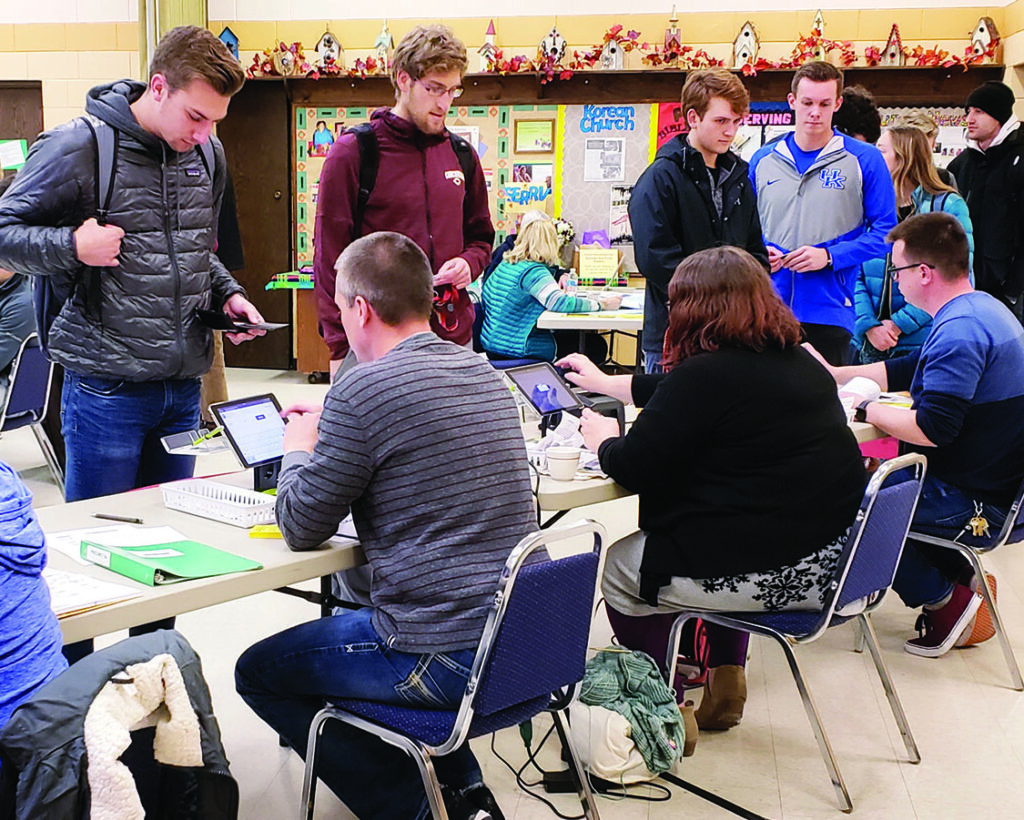
Voters line up to cast their votes during the last general election in 2020. (Photo/Extra file photo)
Minnesota voting system is among best in nation
Nancy Edmonds Hanson
In her 25 years as Clay County auditor, Lori Johnson has never caught a problem in the totaling of election ballots. But don’t think she hasn’t tried.
“We test every one of our vote-counting machines before every election,” says Johnson, who has also held the position of county treasurer for most of her tenure. “We make sure they’re all counting correctly by running a test deck of sample ballots in every machine, then comparing the results.
“We have never — never — found anything that was incorrectly counted.” The only glitch that has ever shown up, she says, is when a machine occasionally refuses to accept a ballot that’s been folded or bent. In that case, it’s quickly swapped out for one that operates smoothly.
She is emphatic: “Our machines just don’t make mistakes.” That includes all the gear from Election Systems and Software — the massive DS450 that counts mail-in and absentee ballots, and the 30 DS200s, the same ones used in Clay County polling sites. For additional certainty, her office conducts post-election reviews after every vote. Three randomly selected precincts’ ballots are counted by hand and then compared with the voting machine totals. “We have never ever found anything wrong,” Johnson asserts.
Johnson is stressing the safety and security of the system in which Clay County voters will cast their ballots Tuesday, Nov. 8, in part because this is an election unlike any other. The equipment, the process of selecting poll workers and the counting after the polls close are all the same. What is different, she observes, is the climate of suspicion and distrust spawned by the Big Lie raised by one candidate’s refusal to accept defeat in the 2020 presidential election.
That dark climate has inspired a flurry of warnings that have arrived in Johnson’s mailbox and those of her counterparts around the state. Last week, Secretary of State Steve Simon warned officials to “be alert” during this midterm election after the FBI and Homeland Security issues two warnings about threats to election workers and voter intimidation. He added, however, that he was not aware of any specific, credible threats: “There is less overall risk in Minnesota than there is in other places.” The FBI singled out states that experienced public disputes, recounts and audits in 2020, including Arizona, Georgia, Pennsylvania and Wisconsin. Minnesota was not listed.
Johnson says that her office has received no threatening communications. What it fielded, though, was an unusual number of identical requests for data on cast-vote records and provisional ballots, data that isn’t available here.
She was also named in a lawsuit by unsuccessful 2020 District 4A candidate Edwin Hahn, who sued her, Secretary of State Simon and winning candidate Heather Keeler. Hahn’s suit sought a “full forensic audit” of the election, in which he received 42% of the vote compared to Keeler’s 57%. It was dismissed two weeks after its filing by District Judge Timothy Churchwell, who cited “substantive and procedural deficiencies.”
The precincts in which Moorhead and other Clay County residents fill out their ballots are set up and operated by the cities and townships under guidance from the county auditor. Poll workers are hired from lists of members provided by the DFL and Republican parties, with an eye to maintaining partisan balance.
Independent poll watchers, Johnson says, are a rarity. “They can’t just walk in,” she explains. “They have to have a letter from a candidate or political party. We rarely have had them in the past.”
Results compiled by the tabulation machines in each precinct are carried to the auditor’s office, where they become part of the official count. None of the machines, Johnson stresses, is connected to the internet, ruling out the possibility of online meddling.
Nor has Minnesota encountered the issue of voting by residents whose U.S. citizenship is questioned — a question resolved last week by the state’s attorney general, who said poll workers cannot question those who come to the polls. Unlike North Dakota, the only state without voter registration, Minnesota requires would-be voters to complete a voter registration application that includes an oath that the person who signs it is a citizen. The same certification appears on absentee ballot applications.
Minnesotans have been able to cast absentee ballots since their requests were fulfilled starting Oct. 3. For many Clay County voters, that’s the only option. Of the county’s 56 precincts, 21 vote exclusively by mail-in ballot, including 18 townships and the towns of Hitterdal, Georgetown and Comstock.
For those who want to avoid the rush on Election Day, direct balloting has been open since Tuesday; it concludes on Monday, the day before the general election. It takes place only at the Clay County Administrative Office at 3510 12th Ave. S. during regular business hours. Voters complete the application for an absentee ballot on site, then fill it out and turn it in directly to the auditor’s staff.
Numbers appear to be down this year. In the midst of the COVID-19 pandemic in 2020, more than half of the 32,413 ballots cast in the county were absentee (17,795). A lower total is anticipated in this off-year election, similar to 2018, when 24,657 votes were cast. That year, 5,731 people voted absentee. This year, the auditor had received 5,700 requests for absentee ballots through Oct. 27, when this interview took place.
“Minnesota’s elections are extremely safe and secure,” she promises. “Our election security procedures are probably the best in the nation.
“But given the suspicions that have been promoted so aggressively for the last two years, I’m afraid it will be a long time before we can restore the public’s trust.”


